Early Office Museum
Vintage Photographs of Office Interiors
~ 1930s-1950s ~
When no date is provided in the Description column below, we
do not know the date of the image or photograph.
We have placed undated images and photographs in their likely chronological
order.
If the Source in the right-hand column is anything other than "Early Office
Museum Archives,"
we do not have the ability to grant permission for use or to provide a high
resolution image.
| Click Image to Enlarge | Description | Source |
 |
Large Office. Photograph by National Photograph and Advertising Co., Chicago, IL. | Early Office Museum Archives |
| Office with front-strike typewriters. | Early Office Museum Archives |
|
| Underwriting Division, Fireman's Fund Insurance Co., Chicago, IL, 1931. | Fireman's Fund | |
 |
Panoramic view of office with a sign that says Commercial Service Co. Designers, Printers, Publishers. Below are enlargements of the left half and then right half of this photograph. | Early Office Museum Archives |
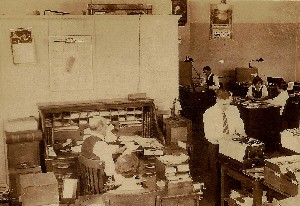 |
This is an enlargement of the left half of the preceding photograph. A wall calendar advertises the Peterson Lumber & Coal Co. A company with that name located in Anderson, IN, was incorporated in 1920. We found references to that company in publications during 1920-23 and 1941. The calendar in question indicates that April 1 was on a Wednesday. From 1920 through 1941 inclusive, April 1 fell on Wednesday in 1925, 1931, 1936. The presence of a candlestick telephone suggests one of the first two years. | Early Office Museum Archives |
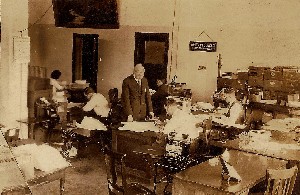 |
This is an enlargement of the right half of the photograph two rows above. There are two Dalton Adding Machines. | Early Office Museum Archives |
 |
Clerks at His Majesty's Stationery Office stuff envelopes in connection with the War Loan conversion program, Engliand, 1932. When interest rates declined during the Depression, the war loan conversion program asked people to accept 2% (according to reports on the internet) or 3.5% (according to the caption on the photo) rather than 5% on investments in government bonds. | Early Office Museum Archives |
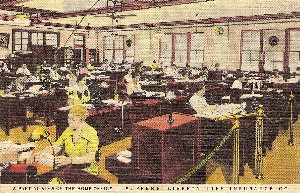 |
Home Office, Supreme Liberty Life Insurance Co., Chicago, IL. Supreme Liberty was founded, owned, managed, and staffed by African Americans and provided life insurance for African American customers. The company was formed by a merger of African American companies in 1929; one of the predecessor companies was founded in 1919. Its headquarters were in Chicago. By the mid-1940s, it had offices in IL, MI, OH, WV, MO, KS, KY, IN, TN, MD, DC, and AZ. In 1929 it had $25 million of insurance in force; when this postcard was published, it had $30 million; and in 1946 it had $105 million. | Early Office Museum Archives |
| Mr. Papper, Auditor's Office, Hotel Roanoke, Roanoke, Virginia, 1930s. There is a Comptometer and another calculator. | Virginia Tech ImageBase, Norfolk & Western Hist. Photo. Coll., No. ns6111. | |
| Bookkeeping office, 1933. Photograph shows 17-column Burroughs electric adding and listing machines, possibly Duplex Adding and Listing or Duplex Subtractor Bookkeeping Machines. | Charles Babbage Institute, Univ. of Minnesota, Minneapolis, Burroughs Corp. Collection, cb000186. | |
 |
Equitable Assurance Co., 1934. Bookkeeping staff using Moon Hopkins bookkeeping machines. | Smithsonian Institution, National Museum of American History, P. A. Juley & Son Collection |
 |
Four women working on Hollerith tabulating machines, Milk Marketing Board, England, 1934. "Information about the number of gallons and rates went onto the producers' cards....[I]t was not until the 1960s that the Board got rid of the last of the Hollerith machines. | Hultun Picture Co. and IRIS Publishing Ltd. |
      |
Six photographs of the Everett H. Eddy insurance agency and
the LeRoy C. Eddy law firm, which shared a small suite of offices, Warren,
PA,1935.
1. Building exterior. The shared offices of
the two firms were on the second floor. The firms' names can be seen
on the window glass. Near Everett Eddy's desk is a calendar advertising the First National Bank, Warren, PA. Census records indicate that an Everett H. Eddy and a LeRoy Eddy were born in Warren, PA, around 1889 and 1890, respectively. |
Early Office Museum Archives |
 |
Auditor of Overcharge Claims, Suspension Relief Claim Bureau, Chicago, Minneapolis, St. Paul & Pacific Railroad, 1935. Twenty-four men are sitting at desks with Dictaphone dictating machines. This office dealt with claims concerning railroad freight charges. | Early Office Museum Archives |
 |
Civilian Conservation Corps office. The Federal Government's CCC, which was segregated, planted an estimated three billion trees from 1933 to 1942. There are typewriters and adding machines. | New Deal
Network http://newdeal.feri.org/ library/a95 |
 |
Works Progress Administration, Recorder of Deeds office. African American clerical workers revising old records, Washington, DC, 1936. | New Deal
Network http://newdeal.feri.org/ library/j86 |
 |
Typists at post office working on identification cards for Social Security, St. Paul, Minnesota, 1936. | Minnesota Historic Society, Neg. No. 39987 |
| Office, 1936. | Courtesy of Québec Commission des Norrmes du Travail and McCord Museum | |
 |
German office with 18 men, at least 5 of whom are working at wide carriage Mercedes tabulating or bookkeeping typewriters. | Early Office Museum Archives |
| Office, Bridgeport Brass, Bridgeport, CT. Bridgeport Brass was founded in 1865 and operated well into the 20th century. | Private collection. | |
 |
Office, Mechanicsburg, PA. From the fact that the photo includes the second Bates Model B stapler, we know that this photo was not taken earlier than 1935. | Early Office Museum Archives |
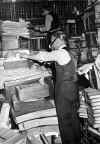 |
Works Progress Administration Census Project Historical Records Survey workers wearing masks while inventorying and surveying records in sub-cellar below river level, New York, NY. The WPA was established in 1935. | New Deal
Network http://newdeal.feri.org/ library/d17b |
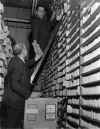 |
Works Progress Administration Record Project workers in the City Hall file room revising the old filing system, Baltimore, MD, 1940. | New Deal
Network http://newdeal.feri.org/ library/j85 |
 |
Lewes Lawes, Warden of Sing Sing Prison, in his office at the prison, Ossining, NY. Notice the prison bars outside the window. Lewis Edward Lawes (1883-1947), a proponent of prison reform and opponent of capital punishment, was warden of Sing Sing from 1920 to 1941. He believed that the function of the penal system was rehabilitation. Until 1943, prisoners at Sing Sing lived in the original cell block built in 1825. Ossining is 30 miles "up the river" from New York City. | Early Office Museum Archives |

 |
Two views of a 3-room office, South Bend, IN, photographer John E. Larkin (b. 1886). | Early Office Museum Archives |
| Click on link at right to see photo. (Click on thumbnail to see full-size image.) When finished, click the "Back" button on your browser to return here. | Teletype room at general office of International Harvester Co., Chicago, IL, 1937. | Wisconsin Historical Society, Wisconsin Historical Images, No. 12015. |
 |
Office with 8 men and 5 women, all at desks. One woman is listening to a dictating machine and transcribing with a typewriter. The spine of a book has the word "Tax." The Ace stapler on a desk indicates that the photo is not earlier than 1936. | Early Office Museum Library |
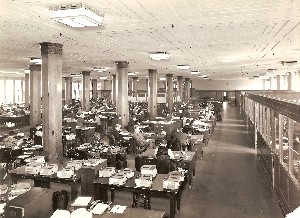 |
Business Office, Detroit News, Detroit MI, 1938. For an enlargement of a portion of this photo, see the next photo. For earlier photos of offices at this newspaper, but not in this building, look at photos from 1899 and 1913 in the Early Office Museum's photo exhibits. | Early Office Museum Library |
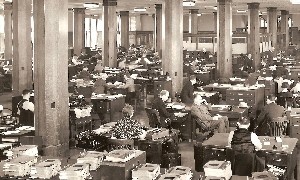 |
This is an enlargement of a portion of the preceding photo. | Early Office Museum Library |
| Edison Ediphone transcription machine operators, Babcock & Wilcox, Ltd., London, England, 1939. Babcock, Wilcox & Co. was founded in 1867 to manufacture industrial boilers. | Edison Historic Site 29320070 | |
 |
Office with 33 women. Photograph by Holtzinger, Tyrone, PA. Many of the women are working at wheeled typewriter stands with small shelving units behind the typewriters. J. H. Holtzinger was a photographer in Tyrone, PA, in the late 1800s and early 1900s, and at some point his business was named Holtzinger's Studio. | Early Office Museum Archives |
| Accounting Department, First National Bank of Chicago, c. 1940. This company had 100 bank bookkeeping machines. | Charles Babbage Institute, Univ. of Minnesota, Minneapolis, Burroughs Corp. Collection, cb000185. | |
 |
Production Department, 1940. Photographs shows Moon Hopkins bookkeeping machines. | Early Office Museum Archives |
| Man in office with Dictaphone dictating machine. | Courtesy of Tom Cameron | |
   |
Arthur E. Blackstone, Chicago District Manager, Dictaphone Corporation, Chicago, IL, 1941, using Dictaphone machines in his office and car. The bottom photo may date from the mid to late 1930s. | Photographs of
Arthur E. Blackstone courtesy of his daughter, Ann
Sanfedele (Barbara Ann Blackstone), who holds copyright. Ann is a published photographer whose own work can be viewed on her website. |
 |
Office, Mohawk Carpets. In 1920, a three-way merger of Shuttleworth Brothers Co., McCleary, and Wallin and Crouse created Mohawk Carpet Mills, Inc. Following ups and downs and numerous mergers, in the early 2000s Mohawk Carpets was the second-largest carpet manufacturer in the US. | Early Office Museum Archives |
 |
"Supply and Mailing Department, National Grange Mutual Liability and Fire Insurance Companies, Keene, New Hampshire." On the back of the postcard someone wrote "Jean 1941." The postcard shows a rotary duplicating machine, a Graphotype machine, and an Addressograph machine. The National Grange, the nation's oldest agricultural organization and a fraternal order known as the Order of Patrons of Husbandry, was founded in 1867 and still exists. The National Grange set up the National Grange Mutual Liability Co. in 1923; the company name was changed to NGM Insurance Co. in 2005. | Early Office Museum Archives |
| Click on link at right to see photo. (Click on thumbnail to see full-size image.) When finished, click the "Back" button on your browser to return here. | Employees record births in the Vault Room in the State Office Building, Capitol Annex, Madison, WI, 1942. In the back center, the photo shows a pneumatic tube system used to send papers. | Wisconsin Historical Society, Wisconsin Historical Images, No. 13866. |
 |
Card Punching Section of the Finance Office, War Department, Washington, DC, 1942. In front of the diagonal white railing, approximately 60 seated women, all African American, are operating tabulating card key-punches. Two standing supervisors are white. The people in this office were preparing allotment checks for dependents of enlisted soldiers. These allotments were authorized under the Service Mens Dependents Act of 1942. | Early Office Museum Archives |
 |
Secretaries, Pentagon, U.S. Department of Defense, Washington, DC, 1943 | Washingtoniana Room, MLK Jr. Library, reproduced in Paul K. Williams, Washington, D.C.: The World War II Years, Arcadia, 2004. |
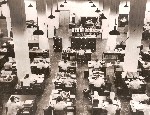 |
Office, Pentagon, U.S. Department of Defense, Washington DC, 1951. "This is one of the large Pentagon office areas where hundreds of soldiers sort and file Army personnel records--one of the many jobs that could be handled by civilians or WACs." | Washingtoniana Room, MLK Jr. Library, reproduced in Paul K. Williams, Washington, D.C.: The World War II Years, Arcadia, 2004. |
 |
File Room, Pentagon, U.S. Department of Defense, Washington, DC, World War II. | Early Office Museum Archives |
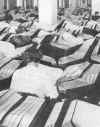 |
Female Clerical Workers Recording Savings Bond Information in Large Ledgers, U.S. Department of the Treasury, Washington, DC, World War II. | Washingtoniana Room, MLK Jr. Library, reproduced in Paul K. Williams, Washington, D.C.: The World War II Years, Arcadia, 2004. |
 |
Secretarial Pool, National Advisory Committee on Aeronautics, ballroom of a private mansion, 1943. | Washingtoniana Room, MLK Jr. Library, reproduced in Paul K. Williams, Washington, D.C.: The World War II Years, Arcadia, 2004. |
| Office of Samuel Plato, Washington, DC, 1943. Samuel Plate was an African American building contractor. All the office workers are African American. | National Archives | |
 |
Interior of Office at U.S. Office of War Information, Washington, DC, 1943. Domestically the OWI (1942-45) disseminated and regulated war news, promoted patriotism, and warned about spies. Abroad it engaged in propaganda and sought to undermine enemy morale. | Courtesy of LIFE Photo Archive |
   |
U.S. Military Offices. Top photo shows tabulating machines used to tabulate data from punched cards. Middle photo shows key punch machines used to punch cards used in tabulating machines . Bottom photo shows teletype machines. | Early Office Museum Archives |
 |
"All Other Expenses Unit of Budget & Acct Section, Federal Bureau of Investigation, July 1944." | Early Office Museum Archives |
 |
Office, Department of Motor Vehicles, Hagerstown, MD, 1944. A half dozen clerical staff are using addressing machines. | Early Office Museum Archives |
| Office in the U.K. | Private collection | |
 |
General Office, Laun Bros Co, Wausaukee WI, 1946. The woman is operating a book typewriter. An adding machine and a typewriter are on a desk behind her. The town of Wausaukee WI was founded in the late 1880s as a logging community. It is located 60 miles north of Green Bay WI and a few miles from Michigan's Upper Peninsula. Wausaukee companies cut largely virgin white and red pine. Jacob and Louis Laun came from a family that operated lumber and furniture manufacturing companies elsewhere in Wisconsin. In 1893, they began to operate a sawmill and a general store in Wausaukee. They also operated a hardware store. Writing on the window in this photograph, which was postmarked in 1946, says "Lumber and Building Materials". An internet search suggests that Laun Brothers was still operating in 1950. | Early Office Museum Archives |
 |
Office with 15 Comptometers, from the Studios of Felt & Tarrant Mfg. Co., Chicago, 1947. | Early Office Museum Archives |
 |
U.S. Department of State, Division of International Press and Publications, Wire Room, Washington, DC, 1949. Integrated work force. "A view of the wire room through which pass 150.... [fix] words a day. The Wireless Bulletin of 7,000 words is sent out twice daily to New York City and San Francisco for broadcast to 50 U.S. diplomatic posts throughout the world. The Division also supplies through these machines complete daily coverage of significant Washington news to the Voice of America Office in New York for broadcast in foreign countries. | Early Office Museum Archives |
  |
Architecture office, by BM Photograph, Business Men's Studio, Beaumont, TX. The lower photo is a detail from the upper photo and shows a woman using the rotary duplication machine. This office also has Monroe and Marchant adding/calculating machines.
|
Early Office Museum Archives |
 |
Office with Edison Voicewriter Cylinder Recording machines (introduced 1937) on first two desks on left; Western Electric/Bell Model 302 telephone (introduced 1937) on first desk on left, and fluorescent lights (introduced commercially 1938). | Early Office Museum Archives |
| General Accounts Section, United Nations, New York, NY, 1951. | Private collection | |
 |
Betty Perino uses a keypunch machine to transfer information from income tax returns to tabulator cards, IRS, Chicago, IL, 1954. Based on an internet search, it seems likely that this is Mrs. Betty A. Perino (1921-2014), who became a long-time resident of Virden, IL, which is 226 miles from downtown Chicago. |
Private collection |
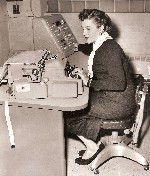 |
Miss Bernice Bieganski, age 23, using electric typewriter, Detroit, MI, 1956. | Early Office Museum Archives |
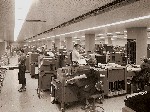 |
Accounting Office filled with IBM punched card tabulating machines, Chicago & North Western Railway, Chicago, IL, 1957. | Private collection |
 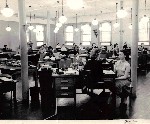 |
Two offices in Chicago, by photographer Fran Byrne. If you can identify these offices, please send an email to teeklake at mchsi dot com, with a copy to curator at earlyofficemuseum dot com. |
teeklake at mchsi dot com |
 |
Office, California. | Private collection |
 |
Office, U.K. The typist closest to the camera is using a Bar-Lock typewriter, presumably a late frontstrike model. | Early Office Museum Archives |
 |
Office of White Rose, New York, NY. White Rose was a large wholesale food distributor. Signs on the walls advertise White Rose Quality Foods and Pique Seasoning. The White Rose private label brand was introduced at the beginning of the 20th century. Pique Seasoning was widely used as a flavor amplifier in the 1940s and was still on the market in the 1970s. White Rose, which is now owned by Di Giorgio Corp., is presently the largest independent wholesale food distributor in the New York City metropolitan area. | Early Office Museum Archives |
 |
Office with Files at Railroad Company. | Early Office Museum Archives |
| Office with Files at Railroad Company | Early Office Museum Archives |
|
 |
Office with typewriters, adding machines, vertical files, 13 women, and 3 men, Chicago, IL. Photograph by Kelly Powell, Chicago, IL. | Early Office Museum Archives |
 |
Office, Payroll Department, Penn Fruit Co., Philadelphia, PA. Penn Fruit Co. operated a chain of supermarkets between 1927 and the late 1970s. At one time, the company boasted that its Philadelphia store at 19th and Market Streets was the largest grocery store in the world. In the photo to the left, there are 3 electric Comptometers and, against the back wall, what appears to be a National Cash Register Co. bookkeeping machine. | Early Office Museum Archives |
  |
Office with manual and electric typewriters, Monroe and Marchant electric calculating machines, and vertical files. | Early Office Museum Archives |
 |
Office, Terre Haute, IN. | Early Office Museum Archives |
Photographs are copyrighted. All rights are reserved by the copyright holder, the owner of the photograph, and the Early Office Museum.